
Brian Harman poses with the Claret Jug.
Jon Super/AP
CNN
—
Brian Harman won the 151st Open Championship on Sunday, sealing the first major of his career in dominant fashion.
Amid a sea of umbrellas at a rain-soaked Royal Liverpool, the American weathered a stormy start to lift the Claret Jug, finishing six shots ahead of Australia’s Jason Day, Austria’s Sepp Straka, South Korea’s Tom Kim and Spain’s Jon Rahm.
The 36-year-old had taken a commanding five-stroke lead into the final round. He rebounded from two early bogeys to card a closing one-under 70 to finish on 13-under par overall, securing him a $3 million winner’s cut of the $16.5 million prize purse.
Harman, ranked 26th in the world, had previously won twice on the PGA Tour since turning pro in 2009, but a runner-up finish at the 2017 US Open had marked the closest the Georgia-born golfer had come to winning one of the sport’s flagship events.
“I’m going to have me a few pints from this trophy, I believe,” Harman said during his winner’s interview.
“This golf course was a real test. It was set up so great, even with the weather … to all the fans, all the nice words and all the people that were back home rooting me on, I appreciate it – thank you so much.”

Harman embraces his caddie on the 18th green.
Lorraine Osullivan/Reuters
Victory in the fourth and final men’s major of the year marks the third straight win by an American after Brooks Koepka secured his third PGA Championship and Wyndham Clark won a first career major at the US Open.
McIlroy’s wait goes on
Masters champion Rahm and 21-year-old Kim will both be left to rue slow starts after the duo began the week with rounds of three-over 74.
Rory’s McIlroy’s wait for a fifth major title will tick over to a decade despite yet another strong showing on the biggest stage, as he finished tied-sixth at six-under overall with Argentina’s Emiliano Grillo.
The Northern Irishman won the last time the Open was hosted at Royal Liverpool nine years ago but never looked in serious contention to repeat the feat, as he closed with a 68.
Remarkably, it marks the 34-year-old’s 20th top-10 major finish since his last major triumph at the 2014 US Open, and his third of the year after finishing tied-seventh and second at the PGA Championship and US Open respectively.
“Every time I tee it up or most times I tee it up, I’m right there,” McIlroy told reporters. “I can’t sit here and be too frustrated. You think about my performances in the majors between like 2016 and 2019, it’s a lot better than that.
“I’m optimistic about the future, and just got to keep plugging away.”

McIlroy’s wait for another major endures.
Luke Walker/Getty Images
Déjà vu
He said the target was 10 hours sleep, but it is difficult to imagine Harman nodded off quickly Saturday night.
To say he had nothing to gain and everything to lose may have been harsh – there are few bigger gains than a first career major – but for those who have performed brilliantly enough to build such a commanding lead heading into the final round, the cruel reality is that anything other than victory will inevitably go down as a catastrophe.

Tyrrell Hatton of England tees off on the 13th hole during Day Three of The 151st Open at Royal Liverpool Golf Club on July 22, 2023 in Hoylake, England.
Tom Shaw/R&A/Getty Images
History was on Harman’s side, with nine of the last 11 players to take a minimum five-stroke lead into the final 18 holes of a major during the last four decades ultimately ending the weekend with silverware.
Yet, the two who didn’t are remembered as golf’s greatest capitulations.
Greg Norman saw a six-shot final round lead disintegrate at the 1996 Masters, while pictures of France’s Jean van de Velde stood ankle deep in the waters at a damp Carnoustie in 1999 – smiling even as his dreams of a Claret Jug and a first career major washed away – are seared into the memories of many golf fans.

A baby-faced McIlroy looked primed to claim his first major title at The Masters in 2011. The 21-year-old teed off with a commanding four-shot final day lead in Augusta and, despite a shaky start, he still led by one at the turn. Yet a skewed drive into the trees at the 10th tee sparked a catastrophic collapse for the Northern Irishman, who dropped six shots over the next three holes to finish the day tied for 15th. Look through the gallery to see more of the biggest meltdowns in the history of golf.
Andrew Redington/Getty Images North America/Getty Images

Sam Snead, US Open (1947) With seven major championships and 82 PGA Tour victories, Snead won pretty much everything there was to win across his legendary career — except the US Open. A four-time runner up at the event, the American came within inches of capturing the elusive title in 1947. Having led Lew Worsham by two shots in an 18-hole playoff with three to play, Snead was pegged back heading into the final hole before missing his putt from inside three feet to lose.
St. Louis Post-Dispatch/AP
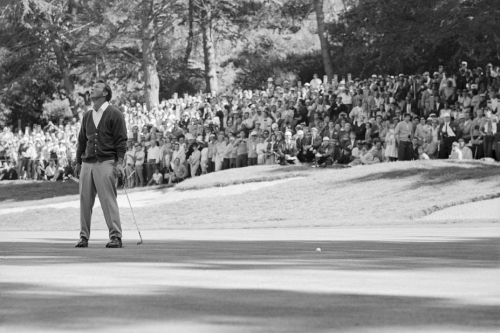
Arnold Palmer, US Open (1966) Even “The King” wasn’t immune to a meltdown. Carrying a seven-shot lead into the back nine of the 1966 US Open, Palmer looked to be strolling towards an eighth career major in San Francisco, only to bogey five of the next seven holes as Billy Casper roared back to force an 18-hole playoff. The nightmare then repeated itself for Palmer, who started strong before dropping four shots across a three-hole stretch to lose out by four strokes to Casper.
Bettmann Archive/Getty Images

Ed Sneed, The Masters (1979) He wasn’t related to Sam Snead, but Ed Sneed saw a major slip away in similarly catastrophic circumstances at The Masters in 1979. Three up with three to play, Sneed slumped to a trio of bogeys to fall into a sudden-death playoff at Augusta — the first time the format had been used. Debutant Fuzzy Zoeller went on to clinch a one-stroke victory over Sneed and Tom Watson. While Watson would finish his career with eight major titles, including two Masters victories, 1979 would cruelly be the closest Sneed ever got to tasting major glory.
Augusta National/Getty Images

Scott Hoch, The Masters (1989) Based on the distance Hoch had to putt to win the 1989 Masters, Nick Faldo had two feet in the grave. Locked in a sudden-death playoff at Augusta’s 10th hole, Faldo could only find the bunker with his approach, leaving Hoch with two bites at a 25-foot putt to win. The American’s first effort took him to within two feet of glory, only for his second to roll agonizingly around the lip of the hole. In response, an exasperated Hoch launched his putter skyward. When Faldo birdied at the subsequent hole, Hoch’s hopes of a first major win similarly went up in the air.
Augusta National/Getty Images
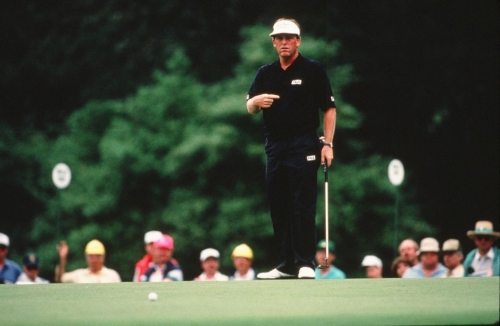
Mark Calcavecchia, Ryder Cup (1991) A traumatic meltdown with a happy ending, Calcavecchia was inconsolable after a collapse that he believed had cost his American team the 1991 Ryder Cup at Kiawah Island. Four up with four holes to play against Colin Montgomerie, the 1989 Open champion looked to be cruising to a crucial point, only to lose all four remaining holes as his Scottish opponent secured a vital half-point for Team Europe. A horrified Calcavecchia looked set to be the scapegoat of a bad-blooded tournament later dubbed “The War on the Shore,” but Germany’s Bernhard Langer spared his blushes by missing his six-foot putt that would have retained the Cup for Europe, sealing a 14 ½ – 13 ½ win for the US.
Augusta National/Getty Images
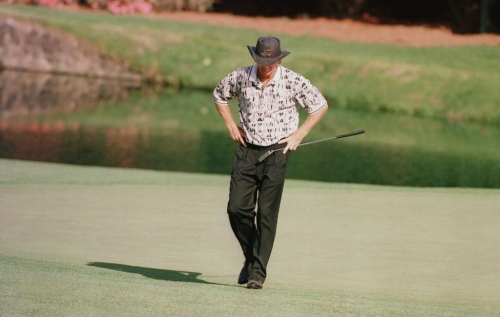
Greg Norman, The Masters (1996) Nicknamed “The Great White Shark,” Norman saw defeat snatched from the jaws of victory at The Masters in 1996. Having led all three rounds and carrying a six-shot lead over Nick Faldo into the final round, the Australian still had a healthy four-stroke lead over the Englishman with 11 to play at Augusta. Faldo didn’t even have to make a birdie to surge into a two-shot lead just four holes later, as Norman sunk with three straight bogeys and a double bogey. Norman bit back with two birdies over the next three holes, but his fate was sealed with another double bogey at the 16th, as Faldo cruised to his sixth major with a five-shot cushion.
David Cannon/Allsport/Getty Images
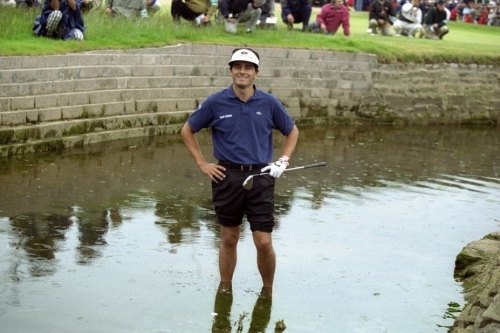
Jean Van De Velde, British Open (1999) A meltdown in equal parts memorable and heart-breaking, Van De Velde’s 18th hole tailspin at the 1999 British Open is one of the most famous implosions in sporting history. Having arrived at Carnoustie in Scotland as the world No. 152, Van De Velde teed off for the last time with a three-shot cushion; even a double bogey would have been enough to crown him as only the second Frenchman to lift the famous Claret Jug. What followed was the golfing equivalent of an anxiety dream, as the 33-year-old skewed his drive, hit his second shot bouncing off a grandstand into the rough, and then watched in horror as his third effort plopped into the Barry Burn. Pictures of Van De Velde — still smiling — stood ankle deep in the water weighing his options have since become the defining images of the tournament as the Frenchman, despite sinking his triple-bogey putt to force a playoff, saw his dreams of a first major usurped by Scotsman Paul Lawrie.
David Cannon/Getty Images Europe/Getty Images
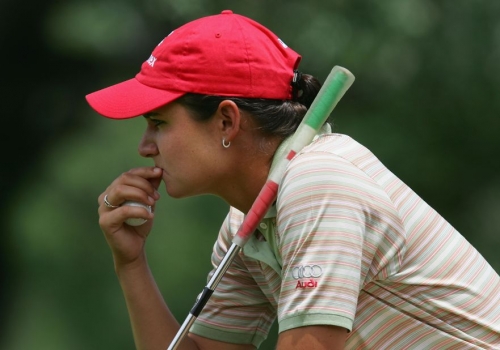
Lorena Ochoa, US Women’s Open (2005) Ochoa secured a top-four finish at the 2005 US Women’s Open. A good display, no? Not when you led at the final hole. The Mexican arrived at the par-four 18th tee at three-under, the score of subsequent winner Birdie Kim, only to skew her opening drive into the water. The 23-year-old eventually tapped in for seven and a triple bogey, finishing the day four shots adrift of the South Korean first-time winner. Ochoa would never get as close to winning the major, but was victorious at the Women’s British Open in 2007 and the Chevron Championship in 2008.
Harry How/Getty Images
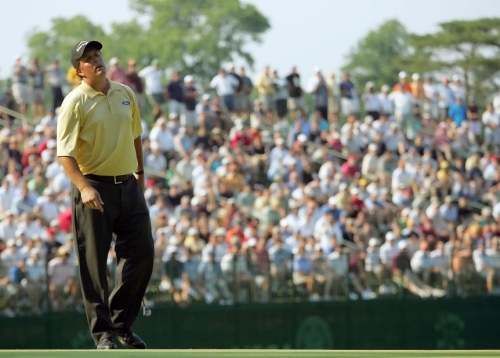
Phil Mickelson, US Open (2006) The US Open remains the only major Mickelson is yet to win, though not for the want of trying. A record-six-time runner-up at the tournament, “Lefty” has never come as close to breaking his duck as he did at Winged Foot in 2006 when, approaching the final hole, he just needed to make par to secure a third consecutive major win. Mickelson subsequently hit a hospitality tent and a tree en route to carding a double bogey which handed victory to Australian Geoff Ogilvy. “I just can’t believe I did that. I’m such an idiot,” Mickelson later told reporters.
Ezra Shaw / Getty Images

Tom Watson, British Open (2009) A five-time Open champion, Watson was a closing par away from making it six and becoming — at 59-years-old — the oldest major winner in golf history, at Turnberry, Scotland, in 2009. To this day, the American believes he hit the “perfect” approach to the 18th green, only for strong winds to whisk his shot past the flag and into long grass. Watson rallied to bogey the hole, but was comprehensively defeated by compatriot Stewart Cink in the subsequent playoff.
Warren Little / Getty Images

Dustin Johnson, US Open (2010) A US Open champion in 2016, Johnson would come to have happy memories of the major — eventually. The 2010 edition of the tournament at Pebble Beach left a distinctly sour taste in the American’s mouth, as Johnson saw his three-shot final day lead evaporate with a disastrous triple bogey at the second hole, from which he never recovered. A double bogey at the following hole was followed by six more across a birdie-less final round, as Johnson finished five shots adrift of Northern Ireland’s first-time major winner Graeme McDowell.
Donald Miralle/Getty Images
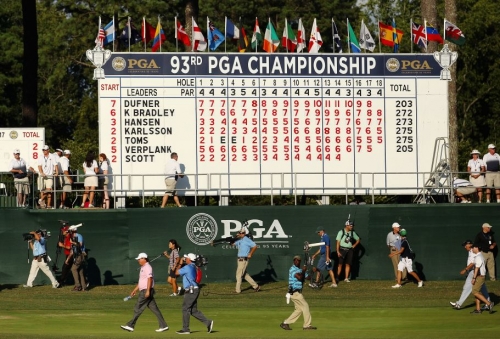
Jason Dufner, PGA Championship (2011) Bogey free after 14 holes, Dufner was a steady finish away from a first major and PGA Tour win at the 2011 PGA Championship in Atlanta. Yet after finding the water from the 15th tee, the American quickly saw his commanding five-stroke lead sink, bogeying three straight holes as rookie Keegan Bradley — who had triple-bogeyed the 15th — fired back-to-back birdies to force a playoff. Bradley completed his comeback to crush his compatriot’s dreams, but Dufner would exorcise his demons with triumph at the 2013 PGA Championship in New York.
Andrew Redington / Getty Images
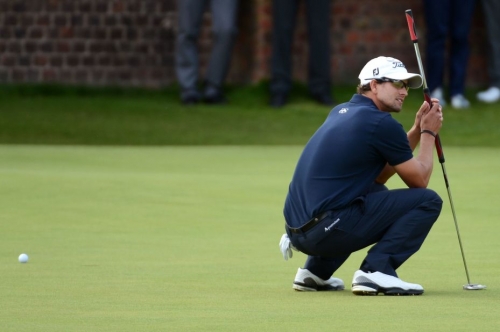
Adam Scott, British Open (2012) When Ernie Els returned to the Royal Lytham and St. Annes clubhouse on the final day of the 2012 British Open, it looked highly unlikely the South African would be back out to lift his second Claret Jug. Yet one Scott capitulation later, “The Big Easy” was doing exactly that, as the long-time Australian leader closed with four straight bogeys to squander a four-shot lead and lose by a single stroke.
Harry How / Getty Images
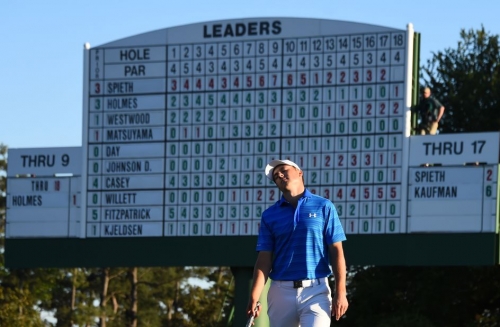
Jordan Spieth, The Masters (2016) “Buddy, it seems like we’re collapsing,” Jordan Spieth told his caddy. Having looked unstoppable in the defense of his 2015 Masters title, five shots clear at the 10th tee, the 22-year-old was spiraling towards an implosion of apocalyptic proportions. Back-to-back bogeys precluded an eye-watering quadruple bogey at the short 12th hole, opening the door for Danny Willett to capitalize and clinch his first major. To rub salt into the wounds, a devastated Spieth had to help the victorious Englishman into his new green jacket at the Augusta winner’s ceremony.
Jim Watson / AFP via Getty Images
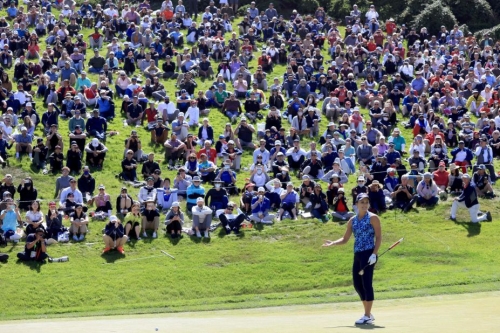
Lexi Thompson, US Women’s Open (2021) The 2021 US Women’s Open provided stories both heart-warming and heart-breaking. Teenager Yuka Saso became the first Filipino player to win a golf major after conquering Japan’s Nasa Hataoka in a playoff, yet neither player had looked to have a shot at victory a short while earlier. Thompson had led by four strokes at the turn, but a back-nine collapse saw her dreams of finally capturing an elusive second major crushed. A par at the final hole would have been enough to put the American into the playoff, but an agonizing missed putt [pictured] epitomized her painful afternoon in San Francisco.
Sean M. Haffey / Getty Images
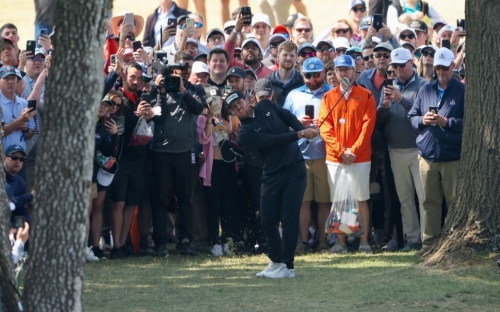
Mito Pereira, PGA Championship (2022) One hole. That’s how close Mito Pereira was to a first major on his maiden PGA Championship outing in 2022. The world No. 100’s fairy-tale story became a horror movie at Southern Hills Country Club in Tulsa as Pereira, leading by a shot, struck his tee drive into the water at the 18th hole. His eventual double bogey meant he missed out on the subsequent playoff, with Justin Thomas besting compatriot Will Zalatoris to lift his second career major.
Christian Petersen / Getty Images
Golf's biggest meltdowns
Prev
Next
As the rain hammered Hoylake on Sunday, it was hard not to feel a sense of ominous déjà vu to the Open’s most notorious implosion.
Though if Harman felt any such anxiety, it was firmly buried at the first tee as the American striped his opening drive down the first fairway before putting for par.
But as he bogeyed the second, the chasing pack were bunching in Harman’s rearview mirror, albeit from a healthy distance. Rahm became the first to break clear and turn up the heat, rolling in his first birdie of the day at the fifth to cut the lead to four.
That temperature cranked even higher moments later when Harman, playing in the group behind the Spaniard, could only bogey the same hole.
Already, the lead was down to three, and the specter of Van de Velde crept a little closer.

Rahm plays a shot on the eighth hole.
Stuart Franklin/R&A/Getty Images
Ghostbuster
Harman quickly found ghostbusting form, and in some style. After draining a brilliant birdie putt from almost 14 feet, the world No. 26 repeated the feat from 10 feet further at the seventh hole.
Just as soon as the door had opened, it had slammed shut, as Rahm’s first bogey of the day before the turn restored Harman’s advantage to six.
It flattened the atmosphere of a damp Hoylake crowd, which had crackled with the sense of potential drama during the opening stages. Harman was more than content to play party pooper, especially after admitting to taking some “unrepeatable” heckles when paired with local favorite Tommy Fleetwood on Saturday.
Read more: Brian Harman shrugs off ‘unrepeatable’ heckles
The chasing quartet did their best to inject more tension into proceedings, but Harman was unflappable. Even when a run of five straight pars was finally broken by a bogey at the 13th, the left-hander corrected course immediately with a birdie.
Breezing through the potentially scary par-three 17th hole with par, Harman carried an umbrella and a six-shot cushion to the final tee. Even as he found a bunker, it made for a comfortable walk down the fairway as he tipped his cap to a rousing reception from the Liverpool crowds.
Having been a picture of steely concentration all afternoon, a wide smile finally broke across Harman’s before he rolled home for par and the championship.
